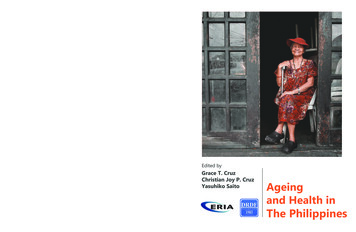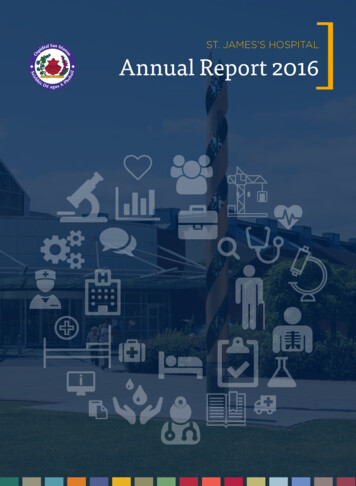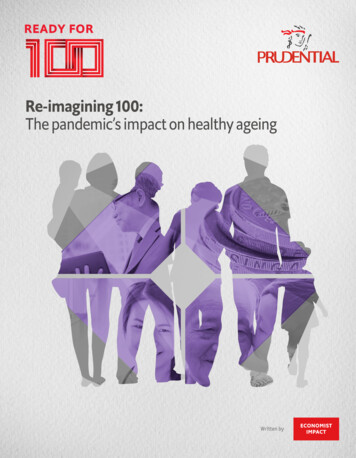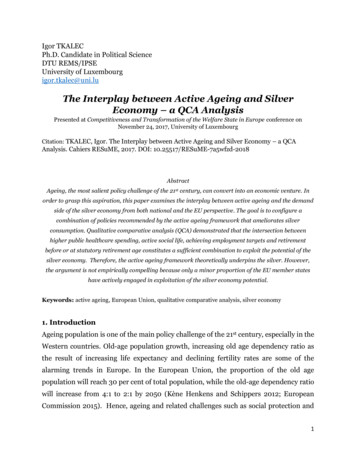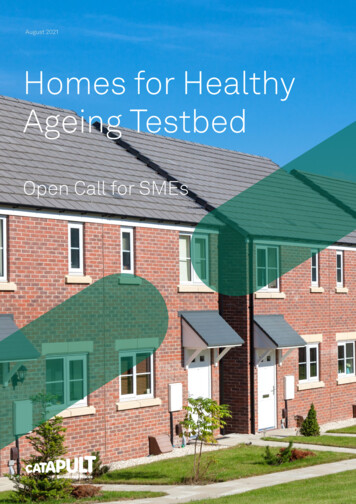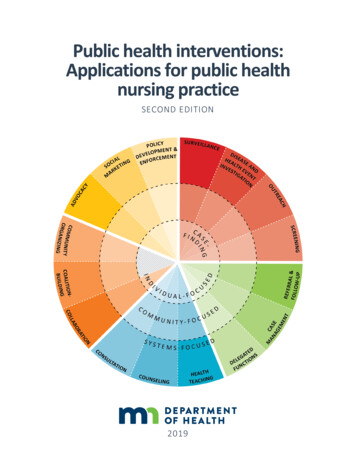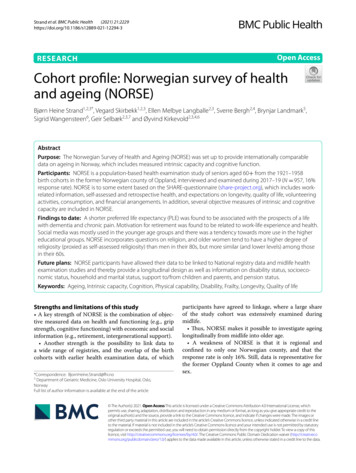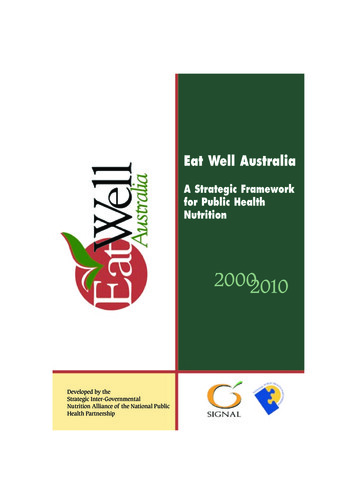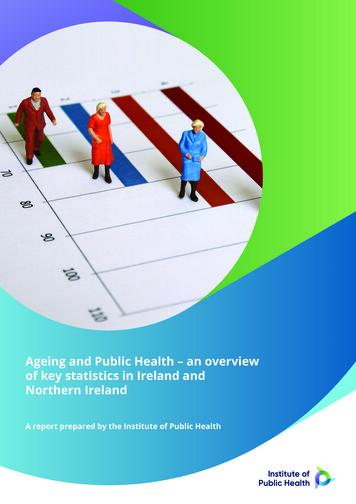
Transcription
Ageing and Public Health – an overviewof key statistics in Ireland andNorthern IrelandA report prepared by the Institute of Public Health
2Ageing and Public Health – an overview of keystatistics in Ireland and Northern IrelandInstitute of Public HealthPublished by The Institute of Public Health. The Institute of Public Health, 2020Prepared by:Aideen Sheehan and Roger O’SullivanTo be cited as:Sheehan, A. and O’Sullivan, R., (2020) Ageing and Public Health – an overviewof key statistics in Ireland and Northern Ireland. Dublin: Institute of PublicHealth.The authors would like to thank former colleagues Conor Breen and the latePaul McGill for their work on a previous version of this report. This report isdedicated to the memory of Paul.The Institute of Public Health has produced this document as a resourcefor public health on the island. It may be freely reproduced withacknowledgement but is not for resale or for use in conjunction withcommercial purposes.
Ageing and Public Health – an overview of key statistics in Ireland and Northern Ireland3Table of ContentsINTRODUCTION 41. THE DEMOGRAPHICS OF AGEING ON THE ISLAND OF IRELAND52. CHRONIC CONDITIONS AND AGEING 103. SOCIO-ECONOMIC INEQUALITIES IN AGEING AND HEALTH IN IRELAND ANDNORTHERN IRELAND14CONCLUSION 24BIBLIOGRAPHY 25
4Institute of Public HealthIntroductionPeople worldwide are living longer thanever before and this is also true on theisland of Ireland. Over the last 100 years,average life expectancy at birth in Irelandand Northern Ireland, has risen by severaldecades. Life expectancy at birth in ROI is80.4 years for men and 84.0 for women(Eurostat, 2017a) while in Northern Ireland(NI) it is 78.7 years for men and 82.4 yearsfor women (DOH NI, 2019a).Population ageing can be seen as one ofthe greatest successes of public health.However, a key challenge is not only theextension of life expectancy but to ensurethose extra years are healthy and disabilityfree for as long as possible. All countriesface major challenges to ensure that theirhealth and social systems are ready to makethe most of this demographic shift.“Worldwide, populations are rapidlyageing. This demographic shift presentsboth opportunities and challenges Many of the challenges associated withpopulation ageing can be addressedby changes in behaviour and policy,especially those that promote good healthin older age. However, so far, the debateon how best to achieve these changes hasbeen narrow in scope. A comprehensivepublic health approach to populationageing that responds to the needs,capacities, and aspirations of older peopleand the changing contexts in which theyfunction is needed”.(Beard and Bloom, 2015).Ageing is a life-long process and ensuringpeople can age healthily and maintainindependence in old age requires alife-course approach. Public healthinterventions can have a significant impacton the quality of ageing in terms of healthoutcomes, disability and quality of life. Thispaper highlights the areas where publichealth and ageing intersect, particularlyfocusing on relevant statistics in ROI and NI.North/South ComparisonsIt is important to note that direct comparisons between different data sources forNorthern Ireland and the Republic of Ireland must be treated with caution, due forexample to the use of different survey methodologies, definitions, question wordingand timeframes, or the fact some disease prevalence data is taken from officialregisters based on different criteria and healthcare systems. Important differenceshave been footnoted in the report, and more details can be found in the originalsources. Please note that for the reasons outlined, comparisons of trends within thispaper are indicative rather than precise.
Ageing and Public Health – an overview of key statistics in Ireland and Northern Ireland11. The Demographics of Ageing in Irelandand Northern IrelandIn line with global trends the populations ofROI and NI are getting older and the shareof older people is set to rise steeply overcoming decades.Figure 1: Projected number of people aged 65 , thousands, 2019-2051Source: CSO, 2018; CSO, 2019a1 ; NISRA, 2019The population aged 65 or over in ROI wasestimated to have reached 696,300 in 2019and 314,700 in NI, meaning the combinedtotal on the island has exceeded 1 millionfor the first time (CSO, 2019a, NISRA, 2019).Figure 1 shows the projected number ofpeople aged 65 doubling to almost 1.6million in ROI by 2051 and exceeding half amillion in NI - bringing the total in this agegroup to over 2 million on the island (CSO,2018, NISRA, 2019). The number of peopleaged 60 or over is estimated at 950,000 inROI in 2019 and is projected to rise to 1.9mby 2051. In NI there are currently 421,000people aged 60 and this is projected to riseto 631,000 by 2051.In 2019 one in seven people on the island ofIreland was aged 65 or over – 17% of the NIpopulation and 14% of the ROI population.It is projected that one in four people (26%)will be over the age of 65 by 2051 in bothROI and NI as shown in Figure 2. Threeout of 10 people in the population of bothjurisdictions will be aged 60 by 2046.1 The 2019 figures for ROI are from the CSO’s population estimates for April 2019. The CSO’s M2F2 population projection based on moderateimmigration and reduced fertility is used for the ROI component of the projected figures for 2021 to 2051 which are based on a 2016 starting point.All NI figures are from NISRA’s 2018-based population projections.5
6Institute of Public HealthFigure 2: People aged 65 as a percentage of total population, 2019-2051Source: CSO 2018; NISRA, 2019The number of people in Ireland, north andsouth aged 85 is also set to accelerate overcoming decades. In 2019 there were 73,000people aged 85 in ROI and this is projectedto rise to 301,000 by 2051 (CSO, 2018, CSO,2019a). In NI there were 39,000 people aged85 in 2019 and this will rise to 103,000 by2051 (NISRA 2019). One in 20 people on theisland of Ireland will be aged 85 by midcentury.The growth in the ageing population hasbeen very rapid on the island of Ireland inthe last decade compared with other EUcountries where this process began earlier.Growth in the older age groups far exceedsgrowth in other age cohorts. While ROI hadone of the youngest populations in Europefor many years, by 2028 there will be morepeople in ROI aged 65 than there will bechildren aged 0-14 (DOH, 2018a). A similarshift is projected for NI with more peopleaged 65 than children aged 0-15 (NISRA,2019).The growth of our older population sincethe 20th Century has been the result ofmany factors including: increased lifeexpectancy due to reduced infant andmaternal mortality, the elimination of manyinfectious diseases, improved water-quality,medical advances and healthier lifestyles.This increased longevity in combinationwith reduced fertility led to huge increasesin the share of older people in thepopulation worldwide.Improvements in life expectancy areprojected to continue over coming decades.Figure 3 overleaf shows the projectedincrease in life expectancy at birth in ROIfrom 2011 to 2051, an increase of 5.5years for women and 7.2 years for men(CSO, 2018). However recent data suggestthe improvements in life expectancy ofrecent decades have started to slow downacross the island of Ireland and manyhigh-income countries, most notablythe US where life expectancy has fallenslightly since 2015 (Raleigh, 2019). In ROIthe slowing of life expectancy gains hasbeen more pronounced amongst womenthan men (Murphy et al, 2019), while inNI there has also been a slowdown inlife expectancy gains with no significantimprovement for women since 2012-14
Ageing and Public Health – an overview of key statistics in Ireland and Northern Irelandand a modest increase for men (DOH NI,improvements, and austerity, but the2019a). The stalling of life expectancy gainsevidence is still unclear (Murphy et al, 2019).is not as pronounced in NI as in the UK asIncreased mortality rates among the overa whole (ONS, 2018). Reasons posited for90s in ROI since 2011 has also been notedslowing life expectancy gains in developedas a cause of concern (Naqvi and Whelan,countries include high influenza mortality,2019).a slowdown in cardiovascular healthFigure 3: Projected increase in life expectancy in ROI, 2011-2051Source: CSO, 2018Life expectancy at age 65 is also animportant measure of an ageingpopulation. In ROI a woman aged 65 in2017 had a remaining life expectancy of21.4 years while a 65-year-old man couldexpect to live another 19.0 years (Eurostat,2017a). In NI the corresponding figures are20.7 years for women in 2016/18 and 18.4years for men (DOH NI, 2019a).Increased longevity is not the onlyimportant measure however, as thenumber of those extra years spent ingood health is crucial to both quality of lifeand service provision. Disability-free lifeexpectancy is a measure used to assessthis2. In ROI, disability-free life expectancyat age 65 has been increasing, standing at13.4 years for women and at 12.5 yearsfor men in 2017 (Eurostat, 2017a). This ishigher than the European Union averageof 10.2 years for women and 9.8 years formen, but lower than in the best-performingcountry Sweden where disability-free lifeexpectancy at age 65 is 15.8 years forwomen and 15.4 years for men.In NI meanwhile the figures for disabilityfree life expectancy at age 65 (calculated bythe Office of National Statistics) to allow forUK-wide comparisons show a woman in NIcould expect to live 9.0 years disability-freein 2016-18, while a 65-year-old man couldexpect to live 9.1 more years disabilityfree,, several years less than their femaleand male counterparts in ROI as shownin Figures 4a and 4b overleaf, thoughdifferences in how this is measured mustbe taken into account (ONS, 2019).2 The ROI measure (Eurostat) is Disability-Free Life Expectancy (DFLE), i.e. the number of years a person is expected to live in a healthy condition freeof limitations to functioning/disability. The DFLE measure in NI (ONS) is estimated years of life free from limiting persistent illness or disability.7
8Institute of Public HealthFigure 4a: Disability-free years expected at age 65 by sex, ROI 2007-2017Source: Eurostat, 2017aFigure 4b: Disability-free years expected at age 65 by sex, NI 2010/12-2016/18Source: ONS, 2018, 2019Looking at the proportion of years peopleaged 65 can expect to live in good health,Figure 5a overleaf shows that in ROImen can expect to spend 66% of theirremaining years disability-free and forwomen it is 63%. Figure 5b overleaf showsthe corresponding proportions in NI are49.3% for men and 43.8% for women. Inboth ROI and NI, women spend a smallerproportion of their remaining years fromage 65 in good health than men do. Thisis more pronounced in NI, whereas the
Ageing and Public Health – an overview of key statistics in Ireland and Northern Irelandgap has narrowed recently in ROI. TheEuropean Union average was 54% for menand 47% for women in 20173. Sweden hadthe highest proportion of disability-free lifeexpectancy at 80% for men and 73% forwomen (Eurostat, 2017a).Figure 5a Disability-free years expected at age 65 as a percentage of life expectancy, ROI2010-17Source: Eurostat, 2017aFigure 5b Disability-free years expected at age 65 as a percentage of life expectancy, NI2014/16-2016/18Source: ONS, 20193 Calculation of % of disability-free life expectancy is derived from Eurostat figures for disability-free years expected at 65 divided by total years of lifeexpectancy at age 65.9
10Institute of Public Health2. Chronic Conditions and AgeingChronic diseases are the major cause ofmorbidity and mortality in both developingand developed countries. This representsa shift from communicable diseases beingthe main cause of mortality in the early20th Century. Many diseases that werepreviously considered to be infectiousor acute conditions are now classified aschronic conditions due to medical advancesin treatment (Scandlyn, 2000). Tobaccouse, unhealthy diet, physical inactivityand lack of access to preventive care allcontribute to increasing prevalence ofchronic diseases such as; heart disease,cancer, stroke, diabetes, and respiratorydiseases (Halpin, Morales-Suarez-Varela, &Martin-Moreno, 2010). The prevalence ofmost chronic conditions increases with age.With the population in NI and ROI ageing,this will mean an increase in the percentageof the population with one or more ofthese conditions. Table 1 shows the mostcommon chronic conditions associated withageing, including prevalence statistics forROI and NI.Table 1: Chronic conditions and ageing statistics for Ireland, North and South 2009/112015/17ArthritisArthritis is aninflammation of thejoints that can cause painand immobility. Thereare many different types,the most common ofwhich is osteoarthritis.Arthritis is a major causeof pain and disability inolder people.Some 10% of the ROI population aged 15 reporthaving arthritis in the past 12 months (DOH, 2019). It isamong the most prevalent chronic conditions amongstolder adults in ROI, with TILDA data showing 39% ofall those aged 56 are affected, rising to 53% amongstthose aged 75 (McNicholas and Laird, 2018). Womenare more likely than men to be affected.In NI 466,000 people or 27% of the total populationare estimated to have a musculoskeletal condition,i.e. arthritis, back pain or osteoporosis (ArthritisResearch UK, 2018). There were 12,721 people onthe rheumatoid arthritis register4 in NI in 2019 (DOHNI, 2019d). Across the UK as a whole, a third ofthe population aged 45 has sought treatment forosteoarthritis, rising to 49% of females and 42% ofmales aged 75 or over (Arthritis Research UK, 2013).4 In NI there are registers of 15 different conditions or diseases for which patients are registered with their GP to receive treatment under the Qualityand Outcomes Framework. These registers obviously do not include people who have not been formally diagnosed with the condition.
Ageing and Public Health – an overview of key statistics in Ireland and Northern IrelandDiabetesDiabetes is a diseasecaused by too high alevel of sugar (glucose)in the blood. Type 1diabetes is caused by anautoimmune condition,while Type 2 diabetesis a metabolic disorderwhich usually developsin adulthood and is oftenassociated with beingoverweight.Coronary Heart DiseaseCoronary heart disease(CHD) is a group ofdiseases that includesangina and heart attack.It is a leading causeof death among olderadults in both NI and ROI.There are 141,500 adults aged 20-79 years withdiabetes in ROI (International Diabetes Federation,2017). Diabetes prevalence increases with age in ROI,to over 11% of the population aged 75 (McNicholas &Laird, 2018). This indicates that a sizeable number ofpeople aged 80 would have to be added to the abovetotal with diabetes.In NI there were 99,833 people on the diabetes registerin 2019, a prevalence rate of 6.4% for the populationaged 17 (DOH NI, 2019d)5.In ROI TILDA data shows 6% of people aged 56 reporthaving had a heart attack and 4.5% report havingangina (McNicholas and Laird, 2018).There were 74,154 people on the coronary heartdisease (CHD) register in NI in 2019, a prevalence rateof 3.7% across the whole population (DOH NI, 2019d).Amongst older people (50 ) prevalence of CHD is 12.4%in NI and 8.6% in ROI. More than twice as many olderpeople in NI have both CHD and limiting long-termillness (8.8%) as in ROI (4.1%) (Cruise et al, 2015).CHD-related disability becomes more prevalent withage e.g. among those aged 50-59 the rates are 1.6% inROI and 4.0% in NI; among those aged 80 the ratesare 8.3% in ROI and 15.2% in NI (Cruise et al., 2015).People in lower socio-economic classes are more likelyto have CHD-related disability than those in high ones(5.0% v 2.9% in ROI and 11.1% v 7.6% in NI). It is alsomore common in men than women (Cruise et al., 2015).Hypertension (highblood pressure)Hypertension is a chroniccondition in which theblood pressure in thearteries is elevated,increasing the risk ofheart attack and stroke.In NI there were 273,895 people on the HypertensionRegister in 2019 giving a prevalence rate of 13.8% (DOHNI, 2019d). People in the most deprived areas were23% more likely to be on blood pressure medicationthan those in the least deprived areas (DOH NI, 2020b).TILDA results in ROI using objective measurementsindicate 40% of older adults (54 ) had high bloodpressure (Nolan, Newman & Donoghue, 2016). Selfreported prevalence rose with age from 29% of thoseaged 56-64 to 49% of those aged 75 (McNicholas andLaird, 2018).5 The raw prevalence rate for the total population of 1.97m GP patients is 4.8%, but the diabetes register only includes people aged 17 so theprevalence rate of 6.2% for that age group is used.11
12Institute of Public HealthHigh cholesterolCholesterol is a fattysubstance found in theblood and necessary forhealthy cells. Howeverif levels are too high itcan cause a build-up ofplaque in blood vessels,increasing the risk ofheart attack and stroke.StrokeA stroke occurs whenpoor blood flow to thebrain causes cell death.There are two main typesof stroke: ischaemic dueto lack of blood flow andhaemorrhagic due tobleeding.CancerCancer is a group ofdiseases involvingabnormal cell growthwith the potential toinvade or spread to otherparts of the body. Thereare over 100 differentknown cancers thataffect humans.TILDA data shows that 41% of older adults (50 ) in ROIhave high cholesterol and this is much more commonamong women than men (51% versus 31%). Highcholesterol is more common amongst people aged50-64, and is lower amongst those aged 65 (Nolan,Newman & Donoghue, 2016).In NI, 17% of NI adults aged 65 had a marginallyelevated cholesterol level while another 23% had amoderately increased level and a further 1% had alevel consistent with severe risk of cardiovasculardisease (Bates et al, 2012).In ROI around 10,000 people of all ages have a strokeannually, while there are upwards of 30,000 peopleliving with disabilities as a result of a stroke. (IrishHeart Foundation/HSE, 2016). TILDA data shows 2%of people aged 50 have had a stroke and prevalencerises with age from 1% of those aged 50-64 to 4% ofthose aged 75 (McNicholas and Laird, 2018).In NI 38,234 people or 1.9% of the total population ofall ages were on the stroke register in 2019 (DOH NI,2019d). Three out of four people who experience astroke are aged 65 or over (HSC, 2017).An average of 22,321 new cases of cancer arediagnosed each year in ROI and the five most commoncancers are non-melanoma skin cancer, prostatecancer, breast cancer, bowel cancer and lung cancer(National Cancer Registry of Ireland, 2018). It isprojected that one in two people in ROI will developcancer during their lifetime (Irish Cancer Society, 2018).The median age group of diagnosis for all cancersin ROI is 65-74 while almost three quarters (74%) ofpeople who die from cancer are over the age of 65(NCRI, 2018).In NI, there were 51,181 people on the cancer registerin 2019, 2.6% of the population (DOH NI, 2019d).Around 9,400 cases of cancer are diagnosed each yearin NI (not including non-melanoma skin cancer). Canceroccurs primarily among older people with 63% of casesin people aged 65 and highest incidence rates in thoseaged 85-89 (N. Ireland Cancer Registry, 2019). Thecancer mortality rate for under-75s is 70% higher in themost deprived areas compared to the least deprivedareas (DOH NI 2020b)
Ageing and Public Health – an overview of key statistics in Ireland and Northern IrelandChronic ObstructivePulmonary Disease(COPD)COPD is the umbrellaterm for a collection oflung diseases includingchronic bronchitis andemphysema. It mainlyaffects those over 35and is most commonlycaused by smoking.DementiaDementia is a broadcategory of braindiseases that causea long term decreasein mental capacity,particularly in theability to process andremember. Alzheimer’sdisease is the mostcommon type ofdementia, followed byvascular dementia whichis related to impededblood flow in the brain.There are several othertypes.Around 110,000 people in ROI have been diagnosedwith COPD but it is thought there are up to 380,000people living with the disease who have not beendiagnosed. It is more common in areas of high socialdeprivation. (HSE, nd). COPD causes over 1,600 deathsa year in ROI and a high number of hospitalisations.Prevalence increases with age with around one in fiveof medical card holders aged 75 on COPD-relatedmedication (Irish Thoracic Society, 2018). TILDAdata indicates 13% of people aged 56 in ROI have arespiratory condition (DOH, 2019).In NI there were 42,235 people on the COPD register in2019, a prevalence rate of 2.1% of the total population.(DOH NI, 2019d). Respiratory mortality (all-cause)for under-75s is over three times higher in the mostdeprived areas compared to the least deprived areas(DOH NI, 2020b).There were estimated to be around 47,000 peoplewith dementia in ROI in 2011 and this number hasbeen projected to grow to 132,000 by 2041 (Pierce,Cahill and O’Shea, 2014). The rate varies by gender andincreases sharply with age – e.g. 1.8% of men and 1.4%of women aged 65-69 have dementia compared with20.9% of men and 28.5% of women aged 85-89.There are 14,646 people on the dementia register inNI in 2019 (DOH NI, 2019d); note - this only includesdiagnosed cases. There were estimated to be almost20,000 people with dementia in NI in 2013 (Prince,2014), with this figure projected to rise to 60,000 by2051 (DHSSPS, 2011).13
14Institute of Public Health3. Socio-economic Inequalities in Ageingand Health in Ireland and NorthernIrelandAcross the island of Ireland there aresocio-economic inequalities in healthamong older people. People in highersocio-economic groups are at lower risk ofchronic conditions and associated disability.Greater socio-economic deprivation isassociated with significantly lower cognitiveperformance and higher levels of bothanxiety and depression and ultimately withearlier death (McNulty et al, 2014). Thereare also very marked gender inequalitiesin health behaviours, specifically in thatwomen are less likely than men to bephysically active, but men are more likely tosmoke and drink heavily.Table 2 uses a selection of areas tocompare ageing and health acrossthe island of Ireland. It shows thatmultimorbidity is more common in NI andlevels of physical activity are lower, butlevels of smoking are broadly similar. Theprevalence of frailty, stroke and CHD inthe NI population is higher than in the ROI.However the underlying reasons for NorthSouth differences remain unclear.Table 2: Key all-island comparative public health statisticsMultimorbidityMultimorbidity is thepresence of two ormore chronic medicalconditions in anindividual. It can havea significant impact onactivity and quality oflife.611% of the population over 50 in ROI suffer from twoor more chronic diseases, compared to 18% of peopleover 50 in NI (Savva et al, 2011)6.People in lower socio-economic groups are twice aslikely to suffer multimorbidity as people in highersocio-economic groups in both NI and ROI (Savva et al,2011).People reporting two or more chronic diseases arenearly 20 times as likely to report disability as peoplewith no chronic conditions (Savva et al, 2011).Eight chronic conditions were included: heart attack, angina, stroke, diabetes, asthma, COPD, musculoskeletal pain and cancer.
Ageing and Public Health – an overview of key statistics in Ireland and Northern IrelandSmokingSmoking is the leadingcause of avoidable deathon the island of Ireland,causing 6,000 deathsin ROI and 2,300 in NIannually. It is a majorcause of lung disease,cancer, stroke and heartdisease.In ROI 19% of those aged 55-64, 13% of those aged 6574 and 8% of those aged 75 smoke (DOH, 2018b).There are marked socio-economic inequalities - forexample women in ROI aged 55-64 living in deprivedareas are four times as likely to smoke as women inaffluent areas (31% versus 8%) while for men in thisage group smoking rates are 31% in deprived areasand 12% in affluent areas (DOH, 2018b).In NI 16% of those aged 55-64, 12% of those aged 65-74and 6% of those aged 75 smoke cigarettes (DOH NI,2020a).NICOLA data indicates that people aged 50 living inthe most deprived areas of NI are three times as likelyto smoke as those in the least deprived areas (30%versus 10%) (Tully, Scott and Cruise, 2017).Alcohol ConsumptionExcessive alcoholconsumption can lead tohigh blood pressure, liverdisease, stroke, injuriesand brain damage.The weekly low-riskguidelines in ROI are 17standard drinks7 for men(170g pure alcohol) and11 for women (110g). NIuses the UK weekly lowrisk guidelines of 14 units(112g) for both men andwomen8.The proportion of older adults who drink alcoholis broadly similar in both jurisdictions falling fromaround three quarters of those aged 55-64 to just overhalf of those aged 75 (DOH, 2018b; DOH NI, 2018).In ROI 52% of men aged 55-64 ‘binge drink’ (6 drinkson typical drinking occasion) compared with 8% ofwomen (DOH, 2018b). TILDA data indicates 16% of menaged 65-74 report problematic alcohol use comparedwith 6.6% of women (DOH, 2019).‘Binge drinking’ in ROI is more common among menin deprived areas than in affluent areas at age 55-64(45% versus 34%), but similar for those aged 65 (DOH,2018b).In NI 33% of men aged 55-64 drink more than the UKweekly recommended limits (14 units/week) as do 8%of women. This falls to 12% of men and 3% of womenaged 75 (DOH NI, 2018).NICOLA data indicates higher rates of drinking aboveweekly limits amongst people aged 50 in the mostdeprived areas of NI compared to the least deprivedareas (39% versus 31%), but little difference byeducation level (Tully et al, 2017).7 In ROI a ‘standard drink’ is 10g of alcohol.8 In NI a ‘unit’ is 8g of alcohol.15
16Institute of Public HealthPhysical ActivityPhysical activity has beenassociated with manybenefits for physicaland mental health, withinactivity linked to thedevelopment of manynon-communicablediseases.In NI NICOLA data indicates 43% of adults aged 50or over did not meet UK recommendations of doingat least 150 minutes per week of moderate exercise.Inactivity rose with age and was lower in those living indeprived areas (Tully et al, 2017).Amongst NI women 41% of those aged 50-64 weredeemed inactive ( 150 mins/week), rising to 47% ofthose aged 65-74 and 68% of those aged 75 . Amongstmen inactivity levels rose from 34% of those aged 5064, to 37% of those aged 65-74 and 50% of those aged75 (Tully et al, 2017).In ROI TILDA data shows 39% of people aged 56 report low levels of physical activity9 and the levels ofinactivity rise with age. Amongst women low activityis seen in 37% of those aged 56-64, 43% of those aged65-74 and 61% of those aged 75 . Amongst men, 24%of those aged 56-64 have low levels of activity, as do30% of those aged 65-74 and 44% of those aged 75 (Healthy and Positive Ageing Indicators, 2019).FrailtyFrailty is a generalweakening of the body,usually, though notinevitably associatedwith ageing. It makespeople more vulnerableto falls and infections.A North South study found that frailty is three timesmore common in people aged 60 in NI than ROI(21% versus 7%)10. Older people in NI were more likelythan those in ROI to have difficulty with walking,stair-climbing, activity, co-morbidity, and especially,exhaustion (38% compared with 9%) (Scarlett et al.,2014).There was a strong socio-economic gradient withpeople from unskilled/semi-skilled backgrounds farmore likely to be frail than people from professional/managerial backgrounds in both NI and ROI (Scarlett etal, 2014).TILDA data (using a different frailty measure to thatcited above) shows frailty affects 12.7% of adults aged50 in ROI and increases with age, doubling in each agegroup from 50-64, 65-74 and 75 . It is twice as commonamongst women as men and amongst those withprimary compared to third level education (O’Halloranand O’Shea, 2018).9 There are a number of different measurements of physical activity available in Ireland North and South. Both NICOLA in NI and TILDA in ROI use theInternational Physical Activity Questionnaire but classify the results slightly differently. NICOLA defines those who do less than 150 minutes per weekof moderate to vigorous activity as inactive in line with UK health guidelines. TILDA’s cut off point for ‘low’ activity is less than 30 minutes moderateactivity on 5 days per week or under specified thresholds for vigorous activities and/or walking.10 Frailty data can often be difficult to compare because items and indices used to measure it may not be identical across different studies. Howeverthe North-South study cited above found NI fared worse than ROI on all frailty criteria considered.
Ageing and Public Health – an overview of key statistics in Ireland and Northern IrelandObesityObesity is an excessiveaccumulation of bodyfat which can have anegative impact onhealth. It increasespeople’s risk ofcardiovascular disease,type 2 diabetes, certaincancers and arthritis.Around three quarters of older adults are overweightor obese across the island of Ireland with only arounda quarter at a healthy weight.Some 29% of adults aged 55-64 in ROI are obese, as are34% of those aged 65-74 and 28% of those aged 75 .The proportions who are overweight are 47% aged 5564, 41% aged 65-74 and 44% aged 75 (DOH, 2019).TILDA data shows obesity is more common in menthan women aged 50 and is less prevalent inwealthier people (Cronin et al, 2011).In NI 34% of adults aged 55-64 are obese – the highestrate of any age group. This falls to 28% of those aged65-74 and 22% of those aged 75 . The proportions whoare overweight are 39% aged 55-64, 41% aged 65-74and 42% aged 75 , and this is more common in menthan women. (DOH NI, 2020a).17
18Institute of Public HealthDisability and InequalitiesThis section explores patterns of disabilityin the population of the island, brokendown by age, gender and socio-economicgroupings.Disability is classified i
3 table of contents introduction 4 1. the demographics of ageing on the island of ireland 5 2. chronic conditions and ageing 10
